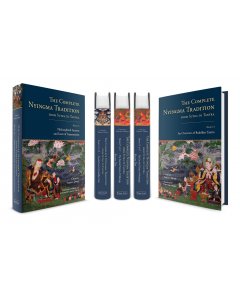See Also: Dudjom Tersar | Longchen Nyingtig | Namcho & Palyul
___________________
Guru Rinpoche | Mandarava | Rongzompa | Longchenpa | Jigme Lingpa | Patrul Rinpoche |
Sera Khandro | Mipham Rinpoche | Dilgo Khyentse | Dudjom Rinpoche
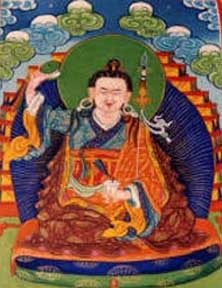

Choying Tobden Dorje (1787–1848) was a brilliant Vajrayana master of eastern Tibet. His masterwork, The Complete Nyingma Tradition from Sutra to Tantra, remains the main text studied by Tibet’s Ngakpa lineages of lay Buddhist yogi-practitioners.
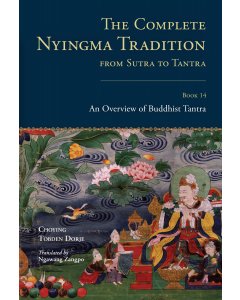
By Choying Tobden Dorje
Translated by Ngawang Zangpo
Contributions by Lama Tharchin
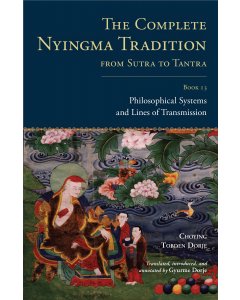
By Choying Tobden Dorje
Translated by Gyurme Dorje
Contributions by Lama Tharchin
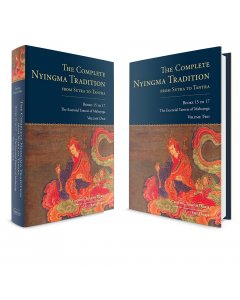
By Choying Tobden Dorje
Translated by Gyurme Dorje
Contributions by Lama Tharchin
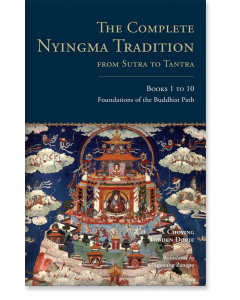
By Choying Tobden Dorje
Translated by Ngawang Zangpo
Contributions by Lama Tharchin
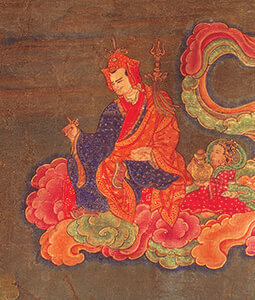
The Guhyagarbha Tantra: A Reader's Guide to the Glorious Secret Essence

See Also: Dudjom Tersar | Longchen Nyingtig | Namcho & Palyul
___________________
Guru Rinpoche | Mandarava | Rongzompa | Longchenpa | Jigme Lingpa | Patrul Rinpoche |
Sera Khandro | Mipham Rinpoche | Dilgo Khyentse | Dudjom Rinpoche
As Kyabje Dungse Thinley Norbu Rinpoche has said, "The ultimate source for the entirety of Sutra and Tantra is the King of Tantras, The Guhyagarbha, Glorious Secret Essence." The Guhyagarbha Tantra summarizes the heart of all eighteen great Mahayoga tantras and is the general tantra of the category of enlightened mind. This Secret Essence Tantra is the most advanced and extensively studied tantra within the Nyingma lineage; and its twenty-two chapters elucidate how to correctly view the ground, traverse the path, and ultimately reach the result-fully enlightened buddhahood.
The tantra of the Glorious Secret Essence (the Guhyagarbha Tantra) extracts the essence of the eighteen Mahayoga tantras and is also the general tantra of enlightened mind. The twenty-two chapters of this tantra describe the three tantras of the ground path and result and explain the topics of tantra needed to perfect the practice.
Studying the Secret Essence is crucial for all who seriously wish to learn any of the three inner tantras, as Mahāyoga is the foundation of all the inner tantras and the Secret Essence is the root tantra of Mahāyoga. The great Mipham writes, “One must learn the tantric trainings by relying on Mahāyoga, as it teaches the ground, path, and result of all tantric cycles.” He also says, “Correct understanding of the visions of all three inner tantras depends on understanding the Secret Essence.” The Secret Essence is also the source of numerous teachings on the one hundred peaceful and wrathful deities, one volume of which—the Tibetan Book of the Dead—is quite popular in the West.
Please note that many of the books listed here require that you have received certain teachings and/or empowerments. Please see the respective book pages for details. Until you receive them, the books are best used as something for your shrine.
$150.00 - Hardcover
By Longchenpa
Translated by Lama Chonam and Sangye Khandro
The twenty-two chapters of this tantra elucidate how to correctly view the ground, traverse the path, and ultimately reach the result—fully enlightened buddhahood.
The first part of this book includes the Tibetan and English translation for the root tantra itself.
The second part of this volume is a translation of the extensive com1nentary on The Guhyagarbha Tantra called Thorough Dispelling of Darkness throughout the Ten Directions written by the omniscient Longchenpa, who was an actual emanation of Samantabhadra. His word-for-word commentary gives uncommon explanations regarding all stages of Vajrayana practice, including comprehensive teachings from the Dzogchen point of view on how to practice and accomplish the path to enlightenment. The author includes complete explanations of the peaceful and wrathful mal).cJalas, as well as practical instructions needed to attain the four states of vidyadharahood.
By Jamgon Mipham Rinpoche
Translated by Lama Chonam and Sangye Khandro
This commentary on the Secret Essence by Mipham Rinpoche illuminates all the crucial points of the entire path of Secret Mantra Vajrayana. The teachings contained in Essence of Clear Light are not only useful for dharma practice in general but are especially applicable for the practice of the three innermost yogas of Secret Mantra. For that application there are the eleven topics well known throughout the teaching of tantra that are clearly elucidated in this text. The topics are: the nature as it is, the view immovable, samadhi forsaking the pass, conduct the array, mandala traversing the stages, empowerment not transgressing, samaya pursuing the goal, accomplishment presentation to the places, offerings the manifestation, enlightened activity binding, mudra and recitation, and mantra. These topics are the crucial points of the path through which the common and supreme siddhis are brought to fruition.
As Mipham Rinpoche points out in this commentary, if these topics are not understood, then there is no other method through which the final result on the path can be achieved. In brief, this excellent text brings an undeniable understanding that all dualistic phenomena arising from the ignorance of grasping and fixating are primordially pure as the truth of inseparable purity and evenness, or the great dharmakaya. Aside from realizing this view, there is no other method through which to receive the genuine wisdom transmission of the lineage of the vidyadhara masters. This doctrine of the great secret, the Guhyagarbha Tantra is the heart essence of a million wisdom dakinis and the path that was traversed by the accomplished vidyadharas of India and Tibet.
$95.00 - Hardcover
$34.95 - Hardcover
By Mipham Rinpoche
Translated by the Dharmachakra Translation Committee
Mipham's explanation of this text, here translated for the first time, is one of the most celebrated commentaries on the Tantra of the Secret Essence, which today occupies an important place in the tantric curriculum of Tibetan monastic colleges. Luminous Essence is a specialized guide meant for initiated tantric practitioners. To fully appreciate and assimilate its message, it should be studied under the guidance of a qualified teacher by those who have received the appropriate empowerments, reading transmissions, and oral instructions.
By Dodrupchen Jigme Tenpa'i Nyima
Translated by Lama Chonam and Sangye Khandro
As the author Dodrupchen Tenpa'i Nyima himself has said, this glorious Secret Essence Tantra possesses eight great features. It is the king of all tantras, pinnacle of all vehicles, origin of all doctrines, general commentary for all scriptural transmissions, core wisdom, intent of all the victorious ones, ultimate state of all results, path that all tathagatas have embarked upon, and great path of all true practitioners. Commentary to the Guhyagarbha Tantra, the Key to the Precious Treasury, synthesizes the meaning of all eighteen Mahayoga tantras from the perspective of the author's personal realization and authoritative scholarship. As the means through which serious practitioners can realize the truth of inseparable purity and evenness, this teaching is the guide for knowing how to internalize the Secret Mantra path of the generation and completion stages.
Th ere are a number of major commentaries3 on the Secret Essence; however, Ihas become one of the four most popular commentaries. It was written by the Third Dodrupchen, a highly
respected scholar and adept. Referring to the Third Dodrupchen’s famous treatise about memory, the Th irteenth Dalai Lama noted, “Today, a writer of this quality is very rare in this land.” The present Dalai Lama has frequently praised the Third Dodrupchen’s writings, too. He says, “Reading Dodrupchen was as if he were stroking my head in confirmation, giving
me confidence that my insight was not unfounded.”
$95.00 - Hardcover
$59.00 - Hardcover
**Note: Books 15-17 is purchased as a single item but is in fact two separate books that ship wrapped together.
By Choying Tobden Dorje
Translated by Gyurme Dorje
Contributions by Lama Tharchin
Two of the books of the Complete Nyingma Tradition, the masterpiece and most extensive presentation of the Nyingma thought and practice available in English, are focused on the Guhyagarbha Tantra. The two books present the entire text of the Guhyagarbha Tantra, in Tibetan and English, together with the interlinear sections of one of its most important commentaries, Dispelling the Darkness of the Ten Directions, by the outstanding fourteenth-century master Longchen Rabjam. Also included is Choying Tobden Dorje’s rewriting of Candragomin’s inspirational Extensive Commentary on the Sublime Litany of the Names of Manjushri.
$24.95 - Paperback
By Ringu Tulku
Ringu Tulku provides several pages on the Guhyagarbha Tantra in his elucidation of the Ri-Me (Rimé) tradition, including its transmission from King Ja to his son Kukuraja to Lialitavajra and Buddhaguhya, who wrote the famous commentary, The Commentary on the Distinctions. Other Indian commentaries include those by Chandragomin and Guru Rinpoche (The Great Explanation by Padma).
The next section describes the Guhyagarbha teaching lineages in Tibet, highlighting masters like Vimalamitra, Ma Rinchen Chok, Nyak Jnanakumara, Nupchen Sangye Yeshe, Katog Dampa Desheg, Rongzompa, Longchenpa, the Zur lineages, and many more.
The following section delves into the three styles of teaching on the tantra:
$22.95 - Hardcover
By Padmasambhava and Mipham Rinpoche
A Garland of Views presents both a concise commentary by the eighth-century Indian Buddhist master Padmasambhava on a chapter from the Guhyagarbha Tantra on the different Buddhist and non-Buddhist philosophical views, including the Great Perfection (Dzogchen), and an explicative commentary on Padmasambhava’s text by the nineteenth-century scholar Jamgön Mipham (1846–1912).
Padmasambhava’s text is a core text of the Nyingma tradition because it provides the basis for the system of nine vehicles (three sutra vehicles and six tantra vehicles) that subsequently became the accepted way of classifying the different Buddhist paths in the Nyingma tradition.
Mipham’s commentary is the one most commonly used to explain Padmasambhava’s teaching. Mipham is well known for his prolific, lucid, and original writings on many subjects, including science, medicine, and philosophy, in addition to Tibetan Buddhist practice and theory.
$29.95 - Paperback
By Rongzom Chokyi Zangpo and Heidi Koppl
This is a translation and study of the great Rongzom Mahpandita's Establishing Appearances as Divine which is usually described in the present-day Nyingma tradition as a commentary on the Guhyagarbha Tantra. If one accepts this classification, it would lend further testimony to Rongzom’s general fondness for the Guhyagarbha teachings and his attempt to validate these teachings through the style of discourse usually associated with the classical dialectical approach. Considering that the initial thesis of Establishing Appearances
as Divine follows almost verbatim that of Padmasambhava in his Garland of Views, a treatise that itself is based on the Guhyagarbha, one may reasonably conclude that the
traditional classification of Establishing Appearances as Divine as a text pertaining to the Mahāyoga class of Tantra is valid.
$34.95 - Paperback
By Mipham Rinpoche and Douglas Duckworth
The Guhyagabha Tantra (or Secret Essence Tantra) appears throughout this work since it is so central to the Nyingma tradition.
Here is an excerpt from one section, but there is a lot more in the book.
The Secret Essence Tantra is the most important tantra in the Nyingma tradition. It comes from a group of eighteen tantras known as the Māyājāla (“the magical net”). The metaphor of the net is significant; it is also used in a sutra where we find the famous image of the jeweled net of Indra, which is said to extend across the universe. It has a jewel at each point where the threads cross, and each jewel reflects each and every other jewel in the entire net. The net is a metaphor for the universe: the whole universe is contained within each single part. The finite is part of the infinite, while the infinite is constituted by and reflected within the finite. The metaphor aesthetically illustrates an important theme in Great Vehicle Buddhism in general and in tantra in particular, namely, the inseparability or unity of nirvana and samsara. Nirvana is not held as somewhere else out there, separate from samsara, like a separate and transcendent infinity apart from the finite. Rather, nirvana is to be discovered within the
nature of samsara. Likewise, the ultimate truth is not to be found separate from the relative truth but within it.In addition to containing the metaphor of the net, the Secret Essence Tantra also extends a theme of universal buddha-nature—the doctrine that all beings have the innate potential to become buddhas—to embrace a view that everything is already the buddha. Thus, the Secret Essence Tantra reveals an important turn within Buddhist thought: a shift from Buddhanature (tathāgata-garbha), the universal potential for enlightenment, to the secret-nature (guhya-garbha), the affirmation of universal enlightenment right now. This turn toward an immanent absolute is a major feature of the tradition of tantra in Tibet, as well as in Buddhist traditions across East Asia.
$34.95 - Paperback
By Jigme Lingpa with commentary by Longchen Yeshe Dorje (Kangyur Rinpoche)
Translated by Padmakara Translation Group
The second volume of Jigme Lingpa's masterpiece relies heavily on the Guhyagarba Tantra in its presentation of Vajrayana and Dzogchen. It quotes liberally from it throughout.
$34.95 - Paperback
By Herbert V. Guenther
World-renowned Buddhist scholar Herbert V. Guenther here offers an early study study of the Dzogchen or Ati tradition of the Nyingma school of Tibetan Buddhism. Matrix of Mystery explores man's ability to preserve as well as transmit essential insights into the structure of reality.
Utilizing a key root Buddhist scripture, the Guhyagarbha ("Matrix of Mystery"), along with dozens of commentarial Tibetan textual sources, Guenther presents the most profound teachings of the Buddhist tradition, which represent the culmination of religious thought and practice in Tibet. In relating these teachings in modern scientific and humanistic perspectives, he demonstrates how, in many cases, the traditional religious and modern secular perspectives on the nature of reality interface.
Professor Guenther discusses the mandala and the deities that reside therein; the organizing principles of body, speech, mind, quality, and action, the three bodies of the buddha (trikaya); the inseparability of prajna and skillful means; and the complex field of Buddhist iconography. Throughout, quotations from numerous Tibetan sources are used to illustrate various teachings. His book will appeal to any serious student of Tibetan Buddhism.
Note: You may also find Khenpo Palden Sherab's Splendid Presence of the Great Guhyagarbha: Opening the Wisdom Door of the King of All Tantras a useful resource.

The Books of the Complete Nyingma Tradition

Home Page of The Complete Nyingma Tradition
>The Books of The Complete Nyingma Tradition
Choying Tobden Dorje and the Story Behind the Complete Nyingma TraditionIn Memorium: Alak Zenkar Rinpoche reflects on Lama Tharchin Rinpoche and the Complete Nyingma Tradition
Lama Sonam Tsering on The Complete Nyingma Tradition
Praise for The Complete Nyingma Tradition

Note that some of the volumes below will not be available in the book trade as they are meant for those who have fulfilled certain prerequisites and are under the guidance of a fully qualified teacher.
Foundations of the Buddhist Path: Books 1-10
Book 1: Discipleship and forsaking misleading companions
Book 2: How the sacred Buddhist doctrine is transmitted through teaching and listening, and how its foundation, faith, is developed
Book 3: The difficulty of attaining a free and fully endowed human life
Book 4: The impermanence of composite phenomena
Book 5: Ennobling and corrupting actions, karma, and consequences
Book 6: The round of rebirth’s nature as suffering
Book 7: Taking refuge; the legal code of the spiritual path of individual liberation; and the basis, path, and result of the hearers’ and solitary sages’ ways of Buddhist practice
Book 8: The middle way’s foundation—the two truths, and the initial uplifting of the mind to awakening
Book 9: The middle way’s path—the twofold cultivation of goodness and wisdom during three intervening incalculable eons
Book 10: The middle way’s result—the two wisdom bodies of final, manifest complete enlightenment
Books 11-12: Translation Forthcoming
Book 11: The array of the realms that fill the bounds of space
Book 12: The ten major and minor subjects of Buddhist culture
This volume presents the philosophical systems of India and Tibet, according to the writings of Longchen Rabjam and the revelations of Orgyan Lingpa. First, it discusses the views attributed to classical Hinduism, Jainism, materialism, and nihilism. Second, it describes the standpoints of the Vaibhashika and Sautrantika exponents of the lesser vehicle, exemplified by pious attendants and hermit buddhas, and the Cittamatra (“mind only”) and Madhyamaka (“middle way”) commentators of the great vehicle, exemplified by great bodhisattva beings. Third, it analyzes the inner and outer vehicles of the Buddhist tantras, with an emphasis on the three classes of the great perfection. Fourth, it documents the lines of philosophical transmission within Tibet, including Bon, Nyingma, Kagyu, Sakya, Kadampa, and Geluk. It concludes with an extract from a well-known treatise of the Fifth Dalai Lama, applying the techniques of consequential reasoning to the first chapter of Vasubandhu’s Treasury of Phenomenology.
An Overview of Buddhist Tantra: Book 14
An Overview of Buddhist Tantra, is the fourteenth book from this collection and the first in the series to focus on tantra. Whereas previous volumes presented the general exoteric teachings of Buddhism, this work outlines the esoteric practice of tantra according to the Nyingma system. The author defines the parameters of tantra by dividing the work into outer and inner tantras, and concludes with explaining the result of the tantric path—enlightenment itself. Designed to be a companion for dedicated practitioners who receive direct instructions from a qualified teacher, this work is a comprehensive manual that provides the foundation for understanding the genuine and profound teachings of Buddhist tantra.
The Essential Tantras of Mahayoga: Books 15-17
The Essential Tantras of Mahayoga is presented in two volumes and concerns the first of the three classes of inner tantra. It presents the entire text of the Guhyagarbha Tantra, in Tibetan and English, together with the interlinear sections of one of its most important commentaries, Dispelling the Darkness of the Ten Directions, by the outstanding fourteenth-century master Longchen Rabjam. Also included is Choying Tobden Dorje’s rewriting of Candragomin’s inspirational Extensive Commentary on the Sublime Litany of the Names of Manjushri.
This translation is comprised of two physical books for the single price.
Anuyoga: Book 18 (Title and translation Forthcoming)
In the commentary to anuyoga tantras, their foundation—empowerment; their vital force—tantric bonds; their path—view, meditation, and conduct; and their result
Atiyoga: Books 19-20 (Title and Translation Forthcoming)
Book 19: Atiyoga, the ground of being. In the commentary to the natural great perfection tantras, their origin and an enumeration of their texts; their foundation—empowerment; and their vital force—the tantric bonds’ four principles
Book 20: The view of Atiyoga. For those of the highest degree of acumen, who can attain freedom in this lifetime—coming to conclusive certainty in the view of atiyoga
Trekchöd: Book 21 (Title and Translation Forthcoming)
This book includes commentary that focuses on trekchöd, the meditation on cutting through the solidity of dualistic experience
Thogal: Book 22 (Title and Translation Forthcoming)
This book includes commentary on thogal, meditation on the four visions within direct vision
Books 23-25 (Title and Translation Forthcoming)
Book 23: Enrichment of spiritual experience through conduct, introduction to the nature of mind, and signs indicative of degrees of success
Book 24: For those of a middle degree of acumen, instruction for liberation during the period between lifetimes; and for those of an average degree of acumen, liberation in the realms of the manifest wisdom body
Book 25: The final result—enlightenment’s five bodies and five wisdoms, and acts of spontaneous enlightened activity
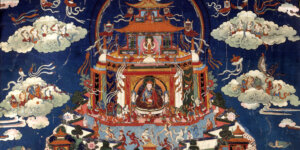
Praise for the Complete Nyingma Tradition

Home Page of The Complete Nyingma Tradition
The Books of The Complete Nyingma Tradition
Choying Tobden Dorje and the Story Behind the Complete Nyingma TraditionIn Memorium: Alak Zenkar Rinpoche reflects on Lama Tharchin Rinpoche and the Complete Nyingma Tradition
Lama Sonam on The Complete Nyingma Tradition
> Praise for The Complete Nyingma Tradition

Translators include Gyurme Dorje, Ngawang Zangpo, and Heidi Nevin. Lama Tsering Gyaltsen has also been instrumental in various aspects of the project.
"This monumental treatise, covering both common and esoteric Buddhist lore, was composed by Choying Tobden Dorje, a most illustrious scholar and accomplished sage. Fortunately, among his voluminous books, this, his masterwork, has survived and has been carefully translated true to the original. It will open the eyes of serious readers to the vast spectrum of Buddhist wisdom."—Tulku Thondup Rinpoche
The Complete Nyingma Tradition from Sutra to Tantra, Books 1 to 10
$49.95 - Hardcover
"The Complete Nyingma Tradition from Sutra to Tantra represents a rare opportunity for readers to obtain a complete map of the Buddha's teachings. It contains very detailed descriptions of the profound and vast teachings of the ground, path, and fruition of both the sutra and tantra traditions. It provides particular emphasis on detailed instructions of the inner tantras of mahayoga, anuyoga, and the precious dzokchen tradition. I highly recommend this book for students who wish to gain a deeper understanding of the complete path to enlightenment."—Orgyen Chowang Rinpoche
The Complete Nyingma Tradition from Sutra to Tantra, Book 13
$39.95 - Hardcover
"The translation of this text is a major milestone in bringing Tibetan Buddhist wisdom to the West. One of the legacies of ancient Tibet is the preservation of vast numbers of the Buddhist scriptures in their most complete and authentic forms. This text is a remarkable example of that. It has the power to reveal the rich traditions of Tibetan Buddhism from its surface to its depth, and it will illuminate the minds of those who have the great good fortune to meet with it."—Anam Thubten
The Complete Nyingma Tradition from Sutra to Tantra, Book 14
$39.95 - Hardcover
We hope you're enjoyed exploring The Complete Nyingma Tradition with our online resource guide. For more information on the current and upcoming publications in this series please refer to the earlier pages of our resource guide including the Home Page of The Complete Nyingma Tradition and The Books of The Complete Nyingma Tradition.
The Complete Nyingma Tradition from Sutra to Tantra, Books 15 to 17
$59.00 - Hardcover
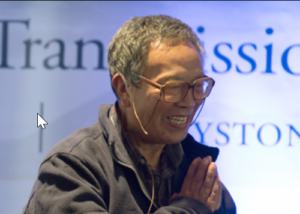
Alak Zenkar Rinpoche on Lama Tharchin Rinpoche

Home Page of The Complete Nyingma Tradition
The Books of The Complete Nyingma Tradition
Choying Tobden Dorje and the Story Behind the Complete Nyingma Tradition
> In Memorium: Alak Zenkar Rinpoche reflects on Lama Tharchin Rinpoche and the Complete Nyingma Tradition
Lama Sonam Tsering on The Complete Nyingma Tradition
Praise for The Complete Nyingma Tradition

The following memoriam by Alak Zenkar Rinpoche for Lama Tharchin Rinpoche is included in each volume of The Complete Nyingma Tradition.

Previously, he was responsible for a thorough proofreading of the edition of The Complete Nyingma Tradition from Sutra to Tantra published by the Sichuan People’s Press and he provided a detailed list of corrections of its typographical errors. Further, he intended to establish both a college and a retreat center based on The Complete Nyingma Tradition from Sutra to Tantra in the homeland of its author, Choying Tobden Dorje. To facilitate studies and experiential cultivation in meditation at those institutions, he oversaw the making of a new electronic version of this text from which a new edition was to be printed. Likewise, in order that The Complete Nyingma Tradition from Sutra to Tantra spread throughout the world, he planned for this work to be translated into both English and Chinese. For example, in the latter case, many years ago, he sponsored the great translator Lodrö Gyatso, a lord among scholars, to translate the outline and other sections of this work into Chinese. The impact of Lama Tharchin Rinpoche’s acts such as these, both completed and ongoing, concerning The Complete Nyingma Tradition from Sutra to Tantra, is of the highest order.
In the midst of his activity in 2013, our merit was insufficient to restrain him and we suffered the loss of his departure to other realms. Nevertheless, his wife Péma Déchen, and Eric Colombel and his other disciples, are now fulfilling his inspired vision by having the entirety of The Complete Nyingma Tradition from Sutra to Tantra printed and distributed. I rejoice in this and offer my heartfelt thanks.
The humble Tübten Nyima
[Zenkar Rinpoche]
July 8, 2014
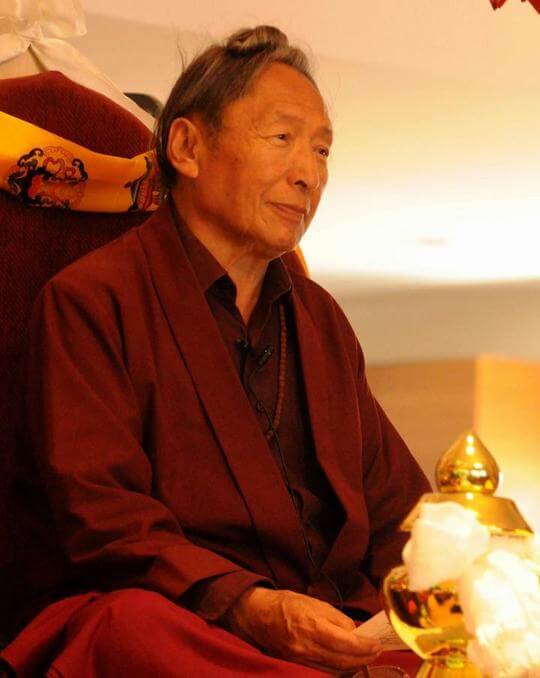
An Interview with Lama Tharchin Rinpoche
The following is from the Snow Lion Newsletter, Winter Supplement 1995
Snow Lion: Rinpoche, can you tell us something about your activities here in the West?
Lama Tharchin Rinpoche: Last time I saw my root teacher, His Holiness Dudjom Rinpoche, his final instructions were for me to take care of the doctrine by teaching and establishing the Dharma. He told me that since I have been educated in Dharma and have gained experience in retreat, it was now time to share what I have learned with others. His Holiness Dudjom Rinpoche's son, Dorje Chang Kyabje Dungse Thinley Norbu Rinpoche, advised me to stay and teach in America where the doctrine has not been previously established.
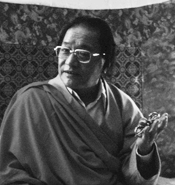
Kyabje Dudjom Rinpoche
When I reflect on my teacher's request and what I want to do with the rest of my life, and I think about what I can give to America and the West, I feel the most profound gift I could possibly give would be the gift of inner peace. We are so wealthy materially, yet we lack the ability to find true and lasting happiness. Each of us has an inherent enlightened Buddha-nature and the ability to find inner peace and contentment. The way to find and reveal the inconceivable qualities within each of us is through the path and techniques of Dharma.
This is the way we can remove the mental suffering and delusion that exists within the samsaric cycling of existence. The unbroken lineage of the Vajrayana teachings can only be held and continued for future generations through education and practice. Education requires the establishment of a college. Practice requires people to do retreat in all forms, including the traditional three-year retreat. Due to my teacher's encouragement, my life goal is to establish these two vehicles for rooting the essence of the Vajrayana teachings in the West.
Two and a half years ago we established the three-year retreat. There are currently eleven people in retreat. We are also in the process of translating a complete treasury of sutra and tantra, a thirteen volume text called the Do Gyud Dzod. [Note: First volume published in 2015 as The Complete Nyingma Tradition Books 1-10] Only one copy of these volumes exists in Tibet, and we have now made a copy and brought it here. When this translation project is complete and if impermanence doesn't come too soon, I would like to establish a college under the direction of Lama Gyaltsen Rinpoche from Vajrayana East in Nepal and Tulku Thubten Rinpoche [Anam Thubten], who is a resident lama at Pema Osel Ling. Since 1986 I have been living in the Santa Cruz area where I have been directing Vajrayana Foundation and Pema Osel Ling retreat and conference center. I feel very pleased that so much progress has been made since I came to the West.
In addition to establishing the three-year retreat and beginning a college, we have also created the Institute for the Preservation of Tibetan Sacred Art. Our plan is to create symbolic supports for bringing enlightened energy to the earth in the form of stupas, statues, libraries and temples, which increase the wisdom and compassion of all sentient beings. So far at Pema Osel Ling, we have finished sculpting a large statue of Guru Rinpoche, which is now being painted and gilded, and an elaborate and permanent sand mandala of Guru Rinpoche's pure' land.
My overall goal is to continue to establish the pure and unbroken Dudjom Tersar lineage in the West. Wherever one can establish a pure lineage, then whoever has the desire to hold that lineage will be able to. This preserves that lineage for the benefit of all beings, now and in the future. Today Tibetan culture and doctrine is very fragile. Some of the lineages of Vajrayana Buddhism have become very thin and are in danger of being lost. My intention is to train Westerners to become lamas who are both educated and experienced practitioners. In this way, the Dudjom Tersar lineage will be strengthened. As Westerners begin to teach, the Dharma can become integrated into this culture without losing the purity of the lineage. Even though I cannot accomplish all of these goals in my lifetime, I hope that others will complete what I have begun.
Due to his great compassion and wisdom, and our extremely good fortune, Dungse Thinley Norbu Rinpoche has granted our request and has agreed to give next summer the entire cycle of Dudjom Lingpa and His Holiness Dudjom Rinpoche's empowerments, transmissions and teachings, which is the Dudjom Tersar lineage. Good fortune of this kind is almost impossible to find, especially for a humble Dharma center like ours. This will be a major event for the Nyingma lineage and Vajrayana tradition.
SL: Please tell us about your experiences with Dudjom Rinpoche.
LTR: Actually, my father sent me to study and train with His Holiness Dudjom Rinpoche in 1943 when I was eight years old. I moved to his monastery, Lama Ling, in Gongpo. My whole childhood was devoted to education, then later I went into retreat.
SL: How long did you stay in retreat with His Holiness?
LTR: First, I spent five years by myself in retreat, then I did a three-year retreat with a group at His Holiness's place. I practiced and received teachings from Dudjom Rinpoche until I escaped to India in 1960. I then traveled with him until 1964 when he established a center in Orissa where I stayed until 1975. My whole life was devoted to serving him and his centers.
SL: Can you tell us something about your relationship with his son Dungse Thinley Norbu Rinpoche?
LTR: We grew up together in Tibet. Later, as I became educated and finished retreat, my understanding improved and I realized how truly amazing he is. I thought that no one in the world could write like Dudjom Rinpoche, and then I read Dungse Thinley Norbu Rinpoche's books. I couldn't believe how sublime his work is, just like his father's. I feel that their qualities are inseparable, and that he is exactly the same as his father.
I received Dzogchen teachings and empowerments from him and became his student Along with His Holiness Dudjom Rinpoche, Lama Sherab Rinpoche and Chatral Rinpoche, I consider Dungse Thinley Norbu Rinpoche to be my root guru.
Dungse Thinley Norbu Rinpoche is an emanation of the great Mahasiddha Longchenpa, whose later emanation was Jigme Lingpa. In his previous lifetime, he was the son of Dudjom Lingpa. Now I can see that Longchenpa, Guru Rinpoche, Dudjom Rinpoche, and Dungse Rinpoche are exactly the same.
SL: Do you think it is important for people to attend the Dudjom Tersar transmissions in July?
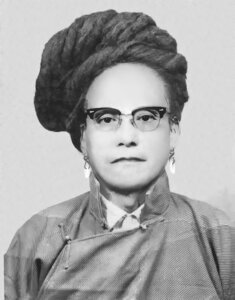
Lama Sherab Rinpoche, Lama Tharchin's uncle
LTR: Yes, absolutely. This is a once-in-a-lifetime opportunity. Dungse Thinley Norbu Rinpoche never gives this type of advanced teaching and empowerments to the public. He is a totally hidden and secret Lama. Due to his incredible compassion and kindness he is willing to pass this lineage to us.
I was recently in Nepal, and when I told people of his intentions, they couldn't believe it. They said that they normally never even get a chance to see him. They were so shocked to hear that he would transmit the whole cycle of empowerments and teachings. This is our incredible good fortune. Since this is such a rare opportunity, I want to let everyone know about this extremely auspicious occasion. Since His Holiness Dudjom Rinpoche passed away, this lineage has already grown weaker. Now we have a wonderful opportunity to make it strong again.
SL: Many people here have very busy lives and will not be able to attend the entire four weeks. Would it be acceptable to attend part of the time?
LTR: Yes, of course, whatever you can do is wonderful. I hope that many of our Dharma friends will be able to come.
***
For further information on the Dudjom Tersar empowerments, write to Dudjom Empowerments, 2013 Eureka Canyon Road, Corralitos, CA 95076, or call 408-724- 2752. The Venerabla Dzogchen master of Vajrayana Buddhism. He is the tenth lineage holder of the Repkong Ngakpas or yogis, which was the largest community of non-monastic practitioners in Tibet. He is loved not onlyfor his inspiring teachings of Buddhist philosophy and meditation, but also for his accomplishments as a master artist. *
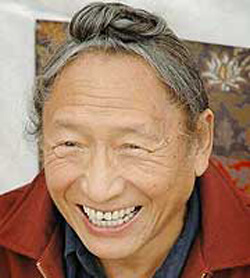
The Complete Nyingma Tradition from Sutra to Tantra, Books 1 to 10
$49.95 - Hardcover
The Complete Nyingma Tradition from Sutra to Tantra, Books 15 to 17
$59.00 - Hardcover
This includes a foreword by Lama Tharchin Rinpoche

